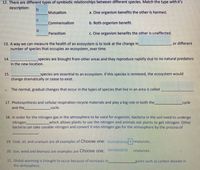
Human Anatomy & Physiology (11th Edition)
11th Edition
ISBN: 9780134580999
Author: Elaine N. Marieb, Katja N. Hoehn
Publisher: PEARSON
expand_more
expand_more
format_list_bulleted
Concept explainers
Question
thumb_up100%
Fill in the blanks

Transcribed Image Text:8. What Is the plcture below illustrating?
Easier bluebird
red-led huwk
9. Interconnected food chains in an ecosystem is called a
food web
Decomposer
10.
work at all levels of the ecosystem by breaking down dead organisms and recycling the
nutrients.
11. Give examples of abiotic and biotic factors.
a. Abiotic:
b. Biotic:
12. There are different types of symblotic relationships between different species. Match the type with it's
description:
Mutualism
a. One organism benefits the other is harmed.
Commensalism
b. Both organism benefit.
Parasitism
C. One organism benefits the other is unaffected.
13. A way we can measure the health of an ecosystem is to look at the change in
number of species that occupies an ecosystem, over time.
or different
14.
in the new location.
species are brought from other areas and they reproduce rapidly due to no natural predators
15.
Species are essential to an ecosystem. If this species is removed, the ecosystem would
change dramatically or cease to exist.
The normal, gradual changes that occur in the types of species that live in an area is called
17. Photosynthesis and cellular respiration recycle materials and play a big role in both the
and the
cycle
cycle,

Transcribed Image Text:12. There are different types of symbiotic relationships between different specles. Match the type with It's
description:
b.
Mutualism
a. One organism benefits the other Is harmed.
Commensallsm
b. Both organism benefit.
Parasitism
c. One organism benefits the other is unaffected.
or different
13. A way we can measure the health of an ecosystem is to look at the change in
number of species that occuples an ecosystem, over time.
14.
species are brought from other areas and they reproduce rapidly due to no natural predators
in the new location.
15.
specles are essentlal to an ecosystem. If this species is removed, the ecosystem would
change dramatically or cease to exist.
The normal, gradual changes that occur in the types of species that live in an area is called
17. Photosynthesis and cellular respiration recycle materials and play a big role In both the
cycle
and the
cycle.
18. In order for the nitrogen gas in the atmosphere to be used for organism, bacteria in the soil need to undergo
nitrogen
bacteria can take useable nitrogen and convert it into nitrogen gas for the atmosphere by the processof
which allows plants to use the nitrogen and animals eat plants to get nitrogen. Other
19. Coal, oll, and uranlum are all examples of Choose one: nonrenew-resources.
20. Sun, wind and biomass are examples are Choose one:
renewable
resources.
21. Global warming is thought to occur because of increases in
the atmosphere.
gases such as carbon dioxide in
Expert Solution
This question has been solved!
Explore an expertly crafted, step-by-step solution for a thorough understanding of key concepts.
This is a popular solution
Trending nowThis is a popular solution!
Step by stepSolved in 2 steps

Knowledge Booster
Learn more about
Need a deep-dive on the concept behind this application? Look no further. Learn more about this topic, biology and related others by exploring similar questions and additional content below.Similar questions
- This dipeptide is designated as: H3N-CH-C-NH-CH-C ČH2 CH2 OH SH O Ser-Lys O Lys-Ser O Ser-Cys O Cys-Ser 1 ptsarrow_forwardWhy some people do and some people do not want to be tested for genetic diseases they might getarrow_forwardCHO CHO CHO CHO CHO но- H- H- -Он но H- OH H- HO- H- HO- но- H- OH HO Но но H- но- OH H- Но H- OH но- Но но- H- HO- ČH2OH CH2OH CH2OH CH2OH ČH,OH I II III IV Varrow_forward
arrow_back_ios
arrow_forward_ios
Recommended textbooks for you
 Human Anatomy & Physiology (11th Edition)BiologyISBN:9780134580999Author:Elaine N. Marieb, Katja N. HoehnPublisher:PEARSON
Human Anatomy & Physiology (11th Edition)BiologyISBN:9780134580999Author:Elaine N. Marieb, Katja N. HoehnPublisher:PEARSON Biology 2eBiologyISBN:9781947172517Author:Matthew Douglas, Jung Choi, Mary Ann ClarkPublisher:OpenStax
Biology 2eBiologyISBN:9781947172517Author:Matthew Douglas, Jung Choi, Mary Ann ClarkPublisher:OpenStax Anatomy & PhysiologyBiologyISBN:9781259398629Author:McKinley, Michael P., O'loughlin, Valerie Dean, Bidle, Theresa StouterPublisher:Mcgraw Hill Education,
Anatomy & PhysiologyBiologyISBN:9781259398629Author:McKinley, Michael P., O'loughlin, Valerie Dean, Bidle, Theresa StouterPublisher:Mcgraw Hill Education, Molecular Biology of the Cell (Sixth Edition)BiologyISBN:9780815344322Author:Bruce Alberts, Alexander D. Johnson, Julian Lewis, David Morgan, Martin Raff, Keith Roberts, Peter WalterPublisher:W. W. Norton & Company
Molecular Biology of the Cell (Sixth Edition)BiologyISBN:9780815344322Author:Bruce Alberts, Alexander D. Johnson, Julian Lewis, David Morgan, Martin Raff, Keith Roberts, Peter WalterPublisher:W. W. Norton & Company Laboratory Manual For Human Anatomy & PhysiologyBiologyISBN:9781260159363Author:Martin, Terry R., Prentice-craver, CynthiaPublisher:McGraw-Hill Publishing Co.
Laboratory Manual For Human Anatomy & PhysiologyBiologyISBN:9781260159363Author:Martin, Terry R., Prentice-craver, CynthiaPublisher:McGraw-Hill Publishing Co. Inquiry Into Life (16th Edition)BiologyISBN:9781260231700Author:Sylvia S. Mader, Michael WindelspechtPublisher:McGraw Hill Education
Inquiry Into Life (16th Edition)BiologyISBN:9781260231700Author:Sylvia S. Mader, Michael WindelspechtPublisher:McGraw Hill Education

Human Anatomy & Physiology (11th Edition)
Biology
ISBN:9780134580999
Author:Elaine N. Marieb, Katja N. Hoehn
Publisher:PEARSON

Biology 2e
Biology
ISBN:9781947172517
Author:Matthew Douglas, Jung Choi, Mary Ann Clark
Publisher:OpenStax

Anatomy & Physiology
Biology
ISBN:9781259398629
Author:McKinley, Michael P., O'loughlin, Valerie Dean, Bidle, Theresa Stouter
Publisher:Mcgraw Hill Education,

Molecular Biology of the Cell (Sixth Edition)
Biology
ISBN:9780815344322
Author:Bruce Alberts, Alexander D. Johnson, Julian Lewis, David Morgan, Martin Raff, Keith Roberts, Peter Walter
Publisher:W. W. Norton & Company

Laboratory Manual For Human Anatomy & Physiology
Biology
ISBN:9781260159363
Author:Martin, Terry R., Prentice-craver, Cynthia
Publisher:McGraw-Hill Publishing Co.

Inquiry Into Life (16th Edition)
Biology
ISBN:9781260231700
Author:Sylvia S. Mader, Michael Windelspecht
Publisher:McGraw Hill Education